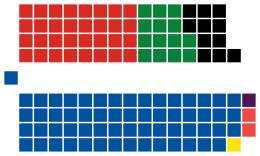New Zealand parliament
| New Zealand Parliament Pāremata Aotearoa |
|
|---|---|
| 51st New Zealand Parliament | |
 |
|
| Type | |
| Type | |
| Houses | House of Representatives |
| History | |
| Founded | 24 May 1854 |
| Leadership | |
|
Elizabeth II
Since 6 February 1952 |
|
|
Dame Patsy Reddy
Since 28 September 2016 |
|
|
Leader of the House
|
|
| Structure | |
| Seats | 121 |
 |
|
|
Political groups
|
Government (63)
Supported by (4)
Opposition (57) |
| Meeting place | |
 |
|
| Parliament House, Wellington, New Zealand | |
| Website | |
| www.parliament.nz/en-NZ | |
Government (63)
Supported by (4)
Opposition (57)
The New Zealand Parliament (Māori: Pāremata Aotearoa) is the legislative branch of New Zealand, consisting of the Queen of New Zealand (Queen-in-Parliament) and the New Zealand House of Representatives. Before 1951, there was an upper chamber, the New Zealand Legislative Council. The Parliament was established in 1854 and is one of the oldest continuously functioning parliaments in the world.
The House of Representatives is a democratically elected body whose members are known as Members of Parliament (MPs). It usually consists of 120 MPs, though sometimes more due to overhang seats. 70 MPs are elected directly in electorate seats and the remainder are filled by list MPs based on each party's share of the party vote. Māori were represented in Parliament from 1867, and in 1893 women gained the vote. New Zealand does not allow sentenced prisoners to vote.
The Parliament is closely linked to the executive branch. New Zealand's government comprises a prime minister (leader of the government) and ministers in charge of government departments; per the tenets of responsible government, these ministers are drawn from the governing party or parties in the House of Representatives.
...
Wikipedia
